SSZTAI6 december 2016 LM27761 , LM27762 , LP5907 , TLE2426 , TPS65133
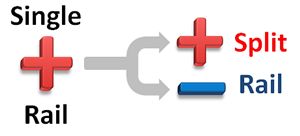
Audio applications, data-signal acquisition and analog sensors benefit from a bipolar bias power supply. A bipolar supply provides the best use of the analog-to-digital converter’s (ADC) dynamic range, enables rail-to-rail amplification, isolates the analog signal from ground noise and offers many other benefits. In this post, I’ll describe three ways to split a single supply rail into a bipolar voltage rail. Table 1 shows the advantages and limitations of each of the three most common methods of splitting a single positive-polarity voltage rail into a bipolar rail.
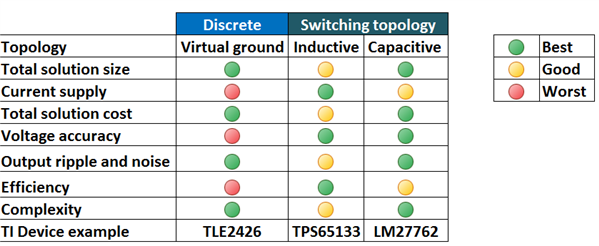
|
The first (and simplest) method is to create a virtual ground by implementing a resistor divider; unfortunately, this configuration is susceptible to becoming unbalanced at very low loads. The TLE2426, shown in Figure 1, creates a common ground buffered from the source; the buffer creates a more stable center point between the rails under load condition. The disadvantage is that it can only handle a few milliamps.
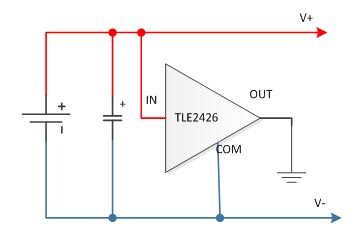
 Figure 1 Simplified Schematic of the
TLE2426 Virtual Ground Driver in a Split-rail Configuration
Figure 1 Simplified Schematic of the
TLE2426 Virtual Ground Driver in a Split-rail ConfigurationSwitching topologies offer higher efficiency, accuracy and stability, as well as more features than a discrete approach. There are two categories of switching regulators: inductive and capacitive (that is, a charge pump or switched capacitor). Inductive regulators are the most efficient devices, but are more complex and require an inductor, increasing bill of materials (BOM) cost and total solution size. Figure 2 shows a typical schematic for the TPS65133, a boost converter with a bipolar output capable of supplying a ±250mA output current with 90% efficiency for most input and output voltage configurations.
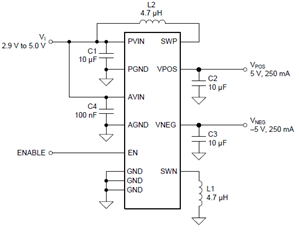 Figure 2 TPS65133 boost converter with
dual output voltage
Figure 2 TPS65133 boost converter with
dual output voltageAnother popular inductive split-rail solution is a fly-buck topology, which is a step-down synchronous buck converter with a coupled inductor in the feedback loop; this topology offers an isolated voltage supply. The fly-buck method is a more complex technique: for step-by-step details, see the application report, “Creating a Split-Rail Power Supply with a Wide Input Voltage Buck Regulator.”
Charge pumps are a popular and easy way of inverting positive rails. You can create a split rail by combining a charge pump with LDOs or DC/DC boost converters, as shown in Figure 2. The LM27761 inverting charge pump in Figure 3 has an integrated adjustable negative LDO capable of supplying 250mA; you can adjust the output voltage using external resistors.
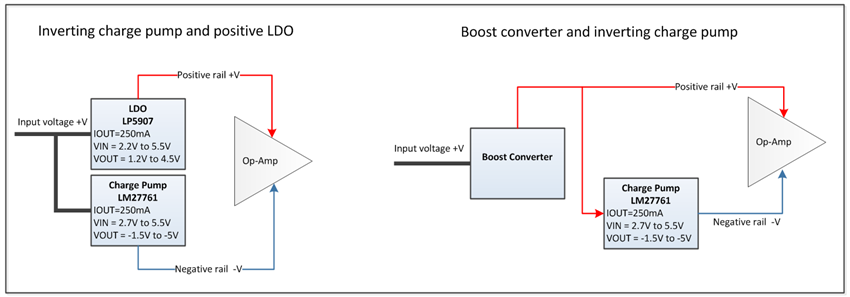 Figure 3 Split-rail Solutions Combine
an Inverting Charge Pump and a Positive Voltage Regulator
Figure 3 Split-rail Solutions Combine
an Inverting Charge Pump and a Positive Voltage RegulatorTI also offers integrated solutions like the TPS65133, which is a boost converter with an integrated LDO and an inverting charge pump capable of supplying ±5V at 90% efficiency. For step-down split-rail applications where you must minimize noise, ripple, cost and space, the LM27762 charge pump has integrated positive and negative LDOs. Again, you can adjust the output voltage with external resistors. The LM27762 requires only a few compensating elements, as shown in Figure 4.
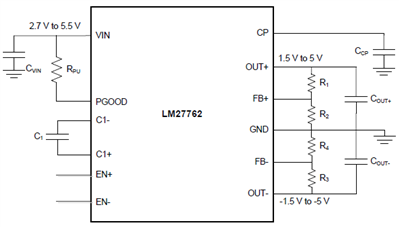 Figure 4 The LM27762 Split-rail Charge
Pump with Integrated LDOs
Figure 4 The LM27762 Split-rail Charge
Pump with Integrated LDOsIn this post, I covered the top three ways to split a voltage rail into a bipolar supply. The discrete solution is a simple solution but is limited on output current, voltage regulation and stability. Inductive switchers have great efficiency, high output current and are capable of isolating the output supply, but the total BOM cost and total solution size are high. Combining the charge pump and LDOs offers low noise, high power supply rejection ratio (PSRR) supply, low cost and small size, but cannot provide currents as high as the inductive solution. Regardless of your application requirements, TI offers a variety of bipolar supply reference designs to get you started on your next design.
Additional Resources
- Get to know “The forgotten converter.”
- Read more about virtual ground circuits.